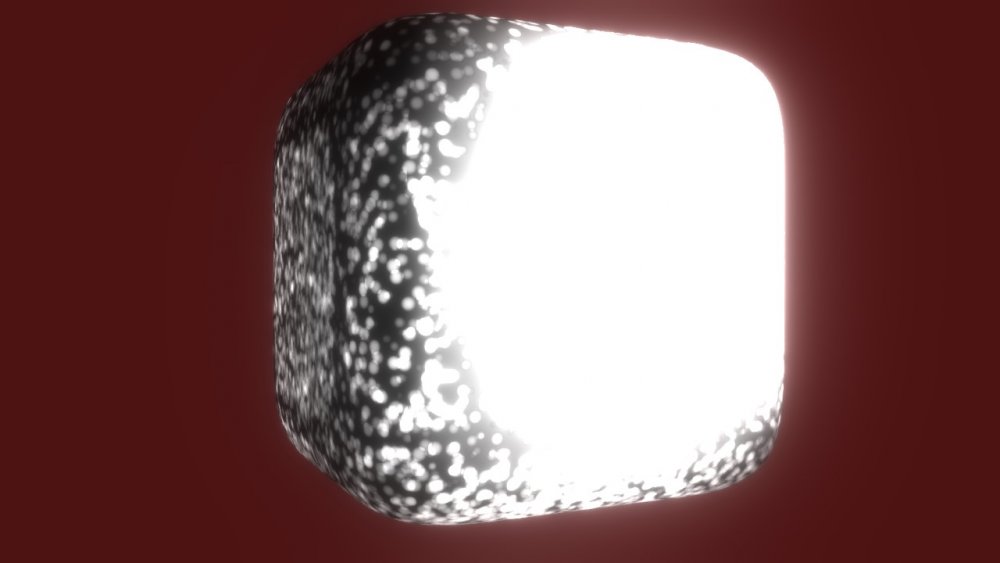Render Particles To Surfaces
Renders particles onto nearby Meshes.

This node renders particles onto nearby 3D surfaces. This means that instead of rendering particles directly into space, they instead appear as dots on 3D geometry, only being visible when they are within a certain proximity to 3D geometry. This is particularly useful when attempting to render particles in a scene rendered by a UV Camera. A spatial grid is used to evaluate the particles, so you may need to add a bounding box and adjust its scale to make sure the particles are evaluated correctly. Reducing the particle size is also a useful step for getting a reasonable quality result.
An image may also be used on the particles, by adding one to the Texture parameter. If an image is not used the sprites will render as a circle with falloff based on particle proximity. The alpha channel of a supplied image is also used to affect particle transparency.
For this node to be effective, Deferred Rendering must be enabled in the Root Node. There must be visible opaque 3D geometry in the scene, and the particles must be close enough to geometry to intersect with it in order to be rendered.
These properties control the core behaviours of the node.
| Parameter | Details |
|---|---|
| Texture | Select a texture to be rendered at each particles position. |
| Particle Size | Edit the size of the particles once they are rendered. |
| Particle X Scale | Control the x-scale of the sprites emitted. |
| Particle Y Scale | Control the x-scale of the sprites emitted. |
| Pixel Align Output | Align the rendered points exactly to screen pixels, with no sub-pixel interpolation. |
| Particle Scale Coeffs | How much the particle scales are affected by the node at different stages of the particle life. Values 1 and 2 are control points, and are used to control the curve between values 0 and 3. |
| Particle Alpha | Change the alpha value for the particles. |
| Visible | Control whether the node is visible or not to the scene. |
| Size Randomness | Control the randomness in size of the particles. |
| Rotation Randomness | ERROR: Variable not found: {att-node-particles-rotation-randomness-description} |
| Luminance Randomness | Control how much randomness is in the luminance of the rendered particles. |
| Screen Size Limits | The minimum and maximum size of the rendered particle in normalised screen coordiates. |
| Specify Size Limits In Pixels | Indicates whether particle size limits are specified in normalised viewport coordinates which are consistent across different render resolutions, or in pixels. |
| Sort Key Value | Biases the depth-based render order, to force the particle system to be drawn before or after other objects in the scene. |
| Depth Bias | Offsets particles in depth so they are closer or further away from the camera, changing the point at which they intersect with the rest of the scene. |
| Motion Blur Amount | Control the amount of motion blur. |
| Use Texture Animation | Edit whether the texture animation is shown with the rendering. |
| Texture Animation Rate | Edit whether the texture animation is shown with the rendering. |
| Num Frames X | Change how many tiles the sprite image will be spread across the x axis. |
| Num Frames Y | Change how many tiles the sprite image will be spread across the y axis. |
| Randomise Start Frame | Randomises the beginning frame the texture animation is played from. |
| Blend Mode | Choose how the particle colours blend to the source colours |
| Rotation Follows Direction | Toggle whether the rotation of the particles follows the direction the particle is moving in. |
| Output Target | Determines which channel the effect is rendered to.
|
| Name | Description | Typical Input |
|---|---|---|
| Bounds Node | The bounding box within which particles are rendered. | Bounding Box |
| Rendered Emitters | Specify which emitters are rendered using this renderer. By default, all emitters connected to the same particle root as the renderer are rendered. | Primitive Emitter |
| Transform Modifiers | Apply the transforms of another node to this node. | Null |
| Target Node | Modifiy the rotations of the node to always direct the z axis towards the input. | Null |
| Local Transform Override | Apply the transforms of another node to this node, relative to its parent. | Null |